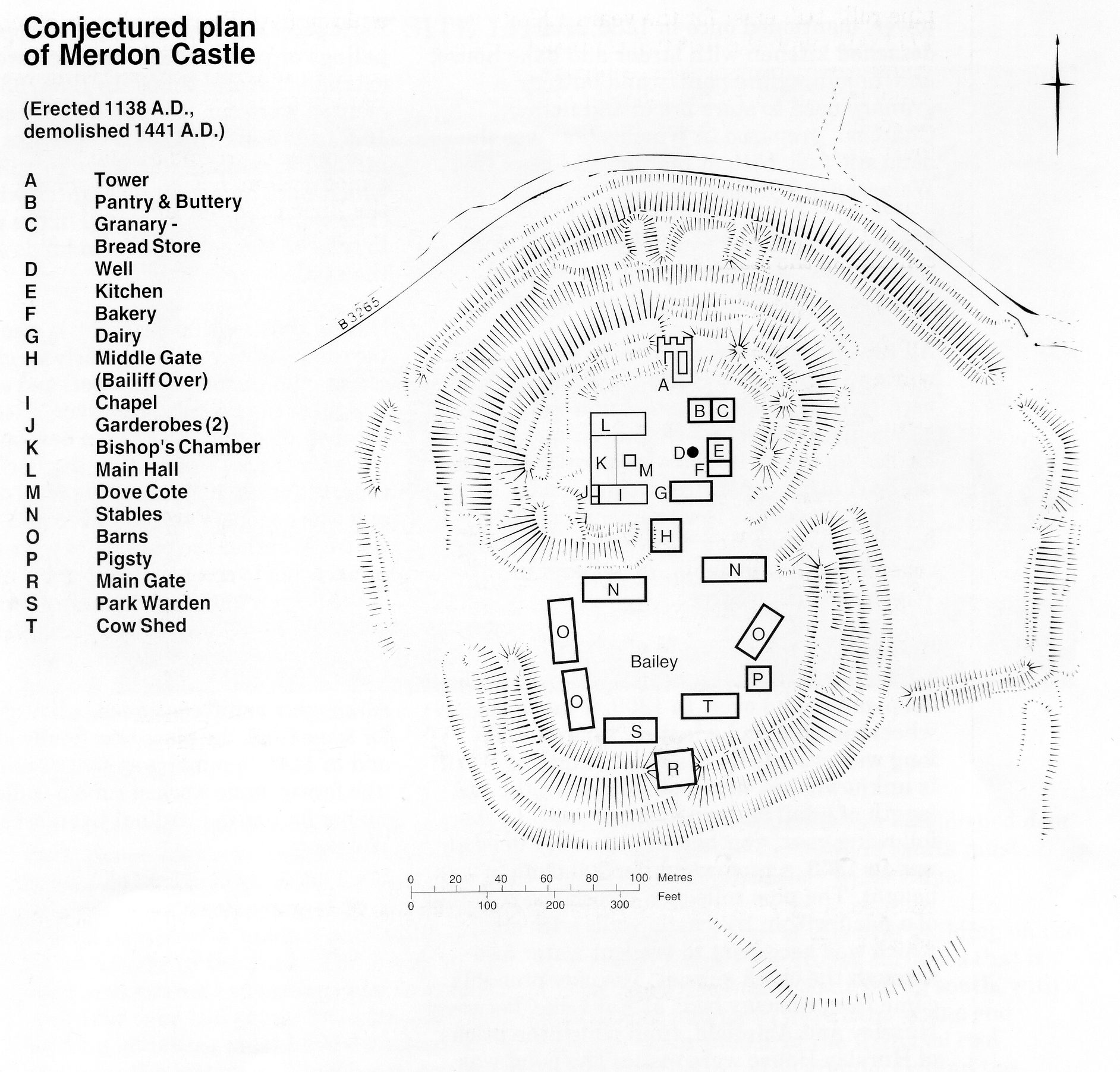Pipe rolls
The bishops of Winchester kept manorial accounts that were summarised in annual counter-rolls, known as ‘pipe rolls’ in imitation of the King’s pipe rolls. These accounts list the income, expenditure and stock of the Bishop’s many estates, and include details of crops, rents, legal transactions, and expenditure on wages, equipment, buildings and entertainment. The pipe rolls still exist for the years 1208 to 1711, although the last two centuries are less informative. From these accounts it is possible to build up the following picture of Merdon Castle in the thirteenth and fourteenth centuries.
A heading of the Merdon accounts from the Bishop's Pipe Rolls of 1334. (Hampshire Record Office Copyright Reserved.)
Entering the castle from the south, one passed through the main gate into the Bailey containing the stables, cow shed, pigsty, barns and the Park Warden’s house all built of wood and wattle. Over the middle gate, between the Bailey and the inner courtyard, were the Bailiff s quarters.
The inner court had all the buildings usual to a medieval manor: a hall, renewed in 1298; the Bishop’s chamber raised on an undercroft, rebuilt in 1283; a chapel with at least four windows mentioned in 1252; a clerks’ room; a tower, mentioned once in 1286; a large detached kitchen with larder and bake house; and, adjoining the pantry and buttery, a granary used to store bread and flour. Charcoal, prepared in Winchester - was the domestic fuel, both at Merdon and at Wolvesey in Winchester.
 Conjectured impression of castle inner court c. 1300
Conjectured impression of castle inner court c. 1300
The main buildings were of stone, but wood (mostly oak) was used whenever possible, especially for ‘timbers, laths and shingles’.
All the buildings were plastered and whitewashed, and roofed with shingles. A pentice ran between the hall and the chapel, alongside the Bishop’s chambers, and in the formed quadrangle was a lawn with dovecote in the centre. (A pentice in this part of Hampshire relates to an upper storey of a building overhanging a pavement, providing cover from the elements, as is found in Winchester High Street.)
Across from the dovecote, near to the kitchens, was the well, which was extremely deep and roofed over. In 1309, it had a cog wheel inserted and a leather rope 44 ‘tails’ long was provided. (The exact length of a ‘tail’ is unknown, but was probably about the tail length of a fully grown horse or cow.) In the following year, another 42 tails were needed, and in 1358, a rope weighing 300 pounds was bought. The pipe rolls also record the relining of a pond within the castle walls with clay, which was necessary to prevent water loss through the chalk subsoil. The clay probably came from the clay beds at Rat Lake, between Hursley and Ampfield, from which the bricks of Hursley House were made. The pond was used for watering the animals.
Park pales (ditches and banks topped with palings or pointed fencing poles) were cut and extended several times. In 1286, 33 ‘perches’ of ditch were cut. Today 1 perch equals about 16.5 feet (5 m). In 1307, 90 perches were cut in ‘the big campus’ and more in 1330, all of which were immediately planted when cut. (The word campus was used in the pipe rolls to refer to the enclosed farm lands south of the castle.)
During the next 100 years, little was spent on the castle. It was used regularly for church ceremonies (mentioned earlier) and as a hunting centre for the Bishops. However, after 1400 its use dwindled until, in 1413, a new building (called a ‘logge’) was built in the Park. By this time, the castle had fallen into total disrepair, and was no longer suitable even as a hunting centre. Whether the park pales were initially constructed to create a deer park is not certain, but this is certainly what this area was in use for in the 1400s, and where better to have the ‘logge’ but near the centre?
Although a bailiff continued to live at the castle for some time, the place was finally abandoned, and in 1441, ‘a miner was sent to rob ashlar’ (the facing stone work of rubble walls) ‘and timber for use in Cardinal Beaufort’s palace at Wolvesey’.